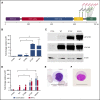High incidence of activating STAT5B mutations in CD4-positive T-cell large granular lymphocyte leukemia
- PMID: 27697773
- PMCID: PMC5114490
- DOI: 10.1182/blood-2016-06-724856
High incidence of activating STAT5B mutations in CD4-positive T-cell large granular lymphocyte leukemia
Figures

References
-
- Loughran TP., Jr Clonal diseases of large granular lymphocytes. Blood. 1993;82(1):1-14. - PubMed
-
- Zhang D, Loughran TP Jr. Large granular lymphocytic leukemia: molecular pathogenesis, clinical manifestations, and treatment. Hematol Am Soc Hematol Educ Program. 2012;2012:652-659. - PubMed
-
- Sabattini E, Bacci F, Sagramoso C, Pileri SA. WHO classification of tumours of haematopoietic and lymphoid tissues in 2008: an overview. Pathologica. 2010;102(3):83-87. - PubMed
Publication types
MeSH terms
Substances
Grants and funding
LinkOut - more resources
Full Text Sources
Other Literature Sources
Research Materials
Miscellaneous

